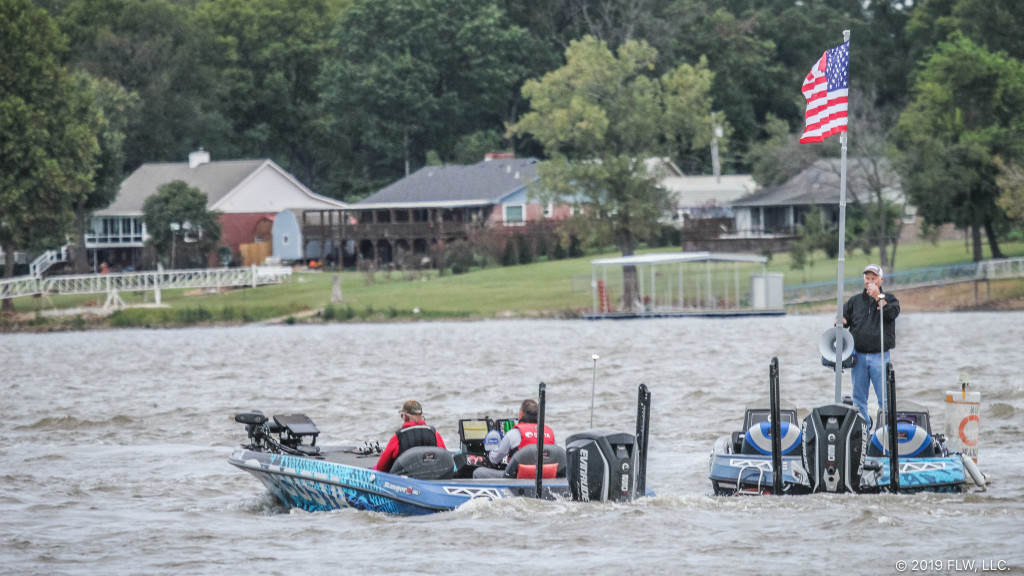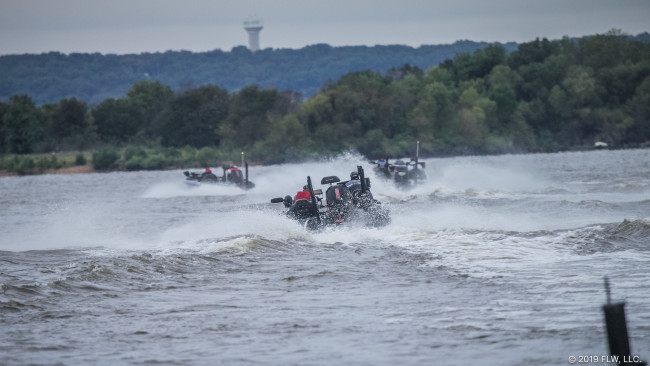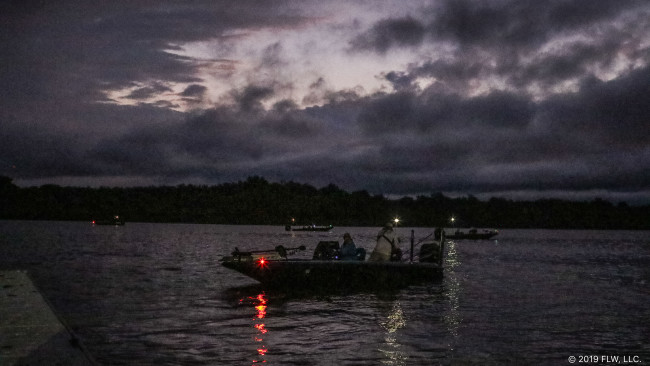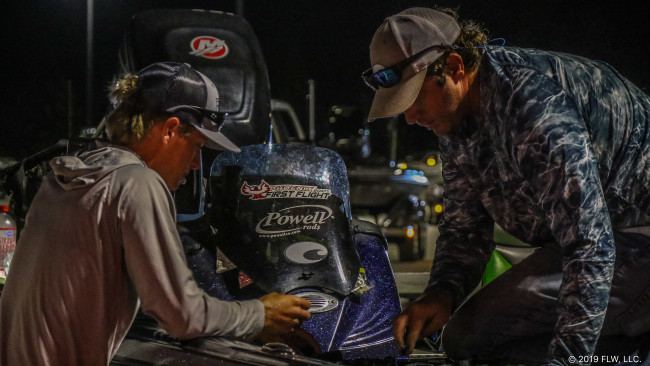Changes Afoot at Grand Lake
Cold snap threatens to throw everyone for a loop in the Southwestern Division finale

Fall is a time of change and movement; two notions bound to impact the outcome of the Costa FLW Series Southwestern Division finale, presented by T-H Marine, on Oklahoma’s Grand Lake. Typical fall migrations are underway, but an approaching cold front will likely complicate the already challenging nature of autumn’s transition.
Nevertheless, Grand Lake has a strong population of largemouth and smallmouth bass, so anglers will lack not for opportunity. Moreover, fish feed heavily this time of year, so it will be interesting to see how the meteorological happenings impact this typically active season.
As the tournament plays out, pros will compete for a top award of up to $50,000 in cash and a new Ranger Z518C boat with a 200-hp Evinrude outboard. Co-anglers will cast for a Ranger Z175 boat with a 90-hp Evinrude outboard and an additional $5,000 if Ranger Cup qualified.

About the fishery
Formally known as Grand Lake o' the Cherokees, this 46,500-acre reservoir in the Ozark foothills is administered by the Grand River Dam Authority, which operates the Pensacola Dam on the Grand River (lower Neosho River). Impounded in 1940, Grand Lake has an average depth of 36.3 feet with 460 miles of rocky shoreline.
Grand Lake habitat includes points, riprap, natural rock banks, docks and the occasional laydown. Major arms include the Elk River, Neosho River, Wolf Creek, Honey Creek, Horse Creek and Drowning Creek.
Torrential spring rains pushed Grand’s water level to nearly 755 feet, but the lake has come down considerably throughout the summer. The current elevation of 744.6 is 2 1/2 feet over conservation pool level of 742, and with the dam releasing water at about 11,500 cubic feet per second, the lake will continue creeping downward – provided the rain in this week’s forecast isn’t too abundant.

Current Conditions
Oklahoma pro Jeff Reynolds, who won the division’s 2017 Lake Texoma event, said the water level will put more shallow cover – willows, stumps, laydowns, etc. – into play. Most profound, Reynolds says, is the impact the high water seems to have had on forage growth.
“There are shad everywhere; there’s more shad than I’ve ever seen on any lake in my life,” he says. “The shad are all over the lake from the main lake to the backs of creeks. It could be that during the high water, the shad could get so far back into the bushes that not much could get to them.
“You can catch fish, but it’s a matter of competing with the shad. If you get in the right spot, you can catch fish, but it’s really hard to pattern anything right now.”
Reynolds says he won’t blame the inconsistency solely on the shad abundance. A lot of it is simply the time of year.
“They’re so scattered out with the fall transition and fish wanting to go back into the creeks,” he adds. “Some are back there, but not as many as there should be.”
Some of that may change with the cold front sliding into the area on day one of the event. Just how quickly the weather changes will determine much, but Reynolds says change of some level is inevitable.
“The highs on tournament days are going to be in the low 70s and it’s going to be getting down into the upper 50s,” Reynolds says. “You never know what that’s going to do to them this time of year. I think if we have clouds, they’ll bite pretty good and the weights will be better, but if the wind doesn’t blow and it gets sunny, it’s going to be tough.”

Tactics in Play
“I think this tournament is going to be anybody’s ballgame,” Reynolds says of the diversity of options available during the fall transition. “It could be won on the bank, out deep or anywhere in between.
“They’re going to be caught on topwaters, they’re going to be caught on square-bills, they’re going to be caught flipping and there will be some guys dragging a Carolina rig or worm out deeper.”
Dicky Newberry, FLW Tour pro and current points leader in the Southwest Division, says this week’s event should line up well for a fish-your-strength strategy. In any case, mobility will complement most game plans.
“I don’t think a guy’s going to be able to win on one spot,” Newberry says. “I think it’s going to be a lot of junk fishing – running and catching one or two fish here and there.”
Critical Factors
- Water clarity – As Reynolds notes, water color varies considerably from the deep, clear areas near the dam, to the stained water upriver. Somewhere between the two extremes is a magical zone were good things happen. Finding the right level and then replicating that scenario in multiple spots will put an angler in good shape “If we get some clouds and some rain, the lower end by the dam is probably going to be better because of the clear water,” Reynolds explains. “If the sun comes out, it may be won up the river; somebody may go up there and catch them flipping or throwing a spinnerbait.”
- Weather – Of course, wind will play a significant role in water color, but Newberry says the frontal movement is likely to do more than muddy windward areas. “The wind has been blowing hard out of the south-southeast, and it has everything muddied up on (the windward) side,” he says. “That’s the side we’re going to have to fish on when the wind switches around with the cold front. I think that’s going to have as much effect on us as anything. I think if you’ve found fish in protected waters – but if you’ve been fishing the lake’s south banks, that have been protected from the south wind – you’re going to be in for a surprise on tournament morning when we have 15-20 mph north winds hammering on the south side.”
- Hungry bass – Sounds obvious, but anglers actually will need to find the fish with the biggest appetites. Doing so will mean avoiding the most heavily bait-laden areas. This one’s a fine line proposition, as it typically stands to reason that bass want to be near food sources. Success may very well come with a touch of randomness, but avoiding coves with bait schools you could walk across will be a wise decision.

Dock talk
Newberry says a local tournament recently saw a winning limit of 20 pounds, and Reynolds believes such a bag is entirely possible this week – especially if the front side of the weather system sparks aggressive feeding.
Reynolds is looking for a two-day total of about 28 pounds to make the final round, with a winning total of about 42.
“It’s just so random right now; it’s going to be about hitting the right spot at the right time, no matter what you’re doing,” he says. “There are patterns to run, but you’re not necessarily going to catch them everywhere you go.”
Tournament details
Format: All boaters and co-anglers will compete for two days. The top 10 boaters and co-anglers based on cumulative weight after two days of competition will advance to the third and final round, with the winner in each category determined by the heaviest cumulative three-day weight.
Takeoff Time: 7:30 a.m. CT
Takeoff Location: Wolf Creek Park, 963 N. 16th Street, Grove, Okla.
Weigh-In Time: 3:30 p.m. CT days one and two, 3 p.m. CT on day three.
Weigh-In Location: Wolf Creek Park